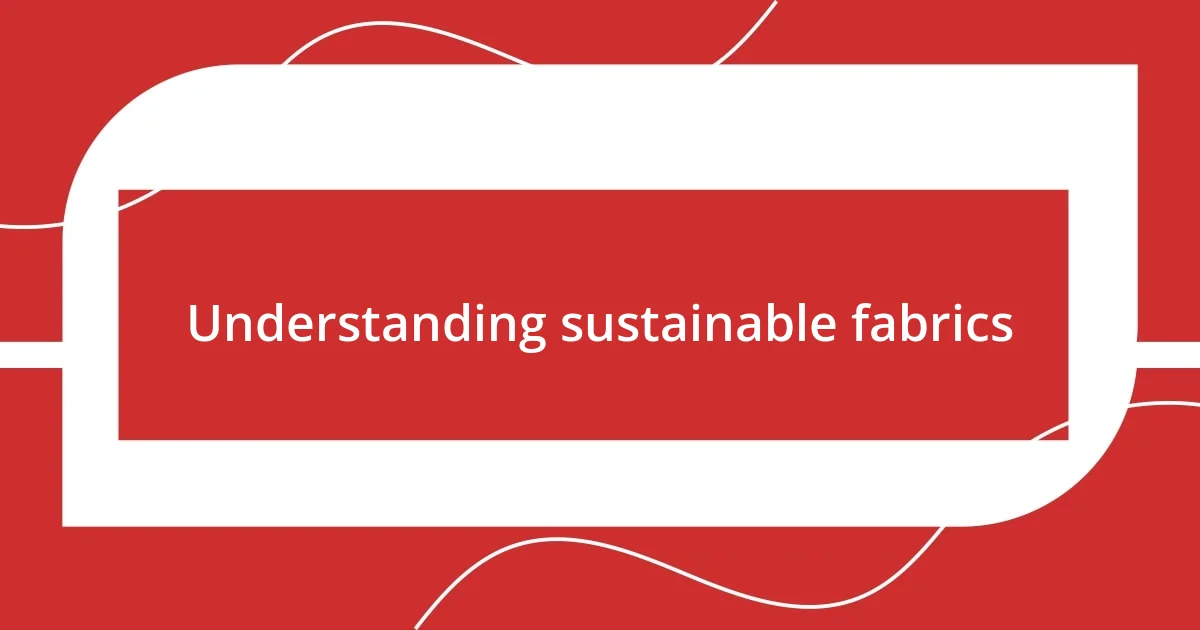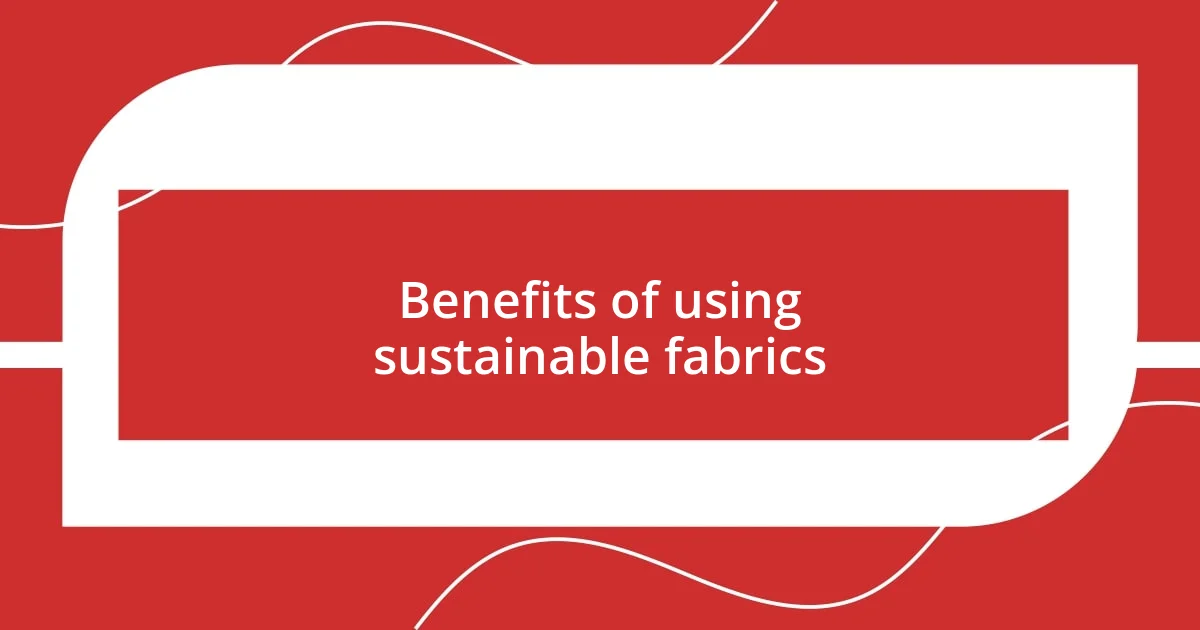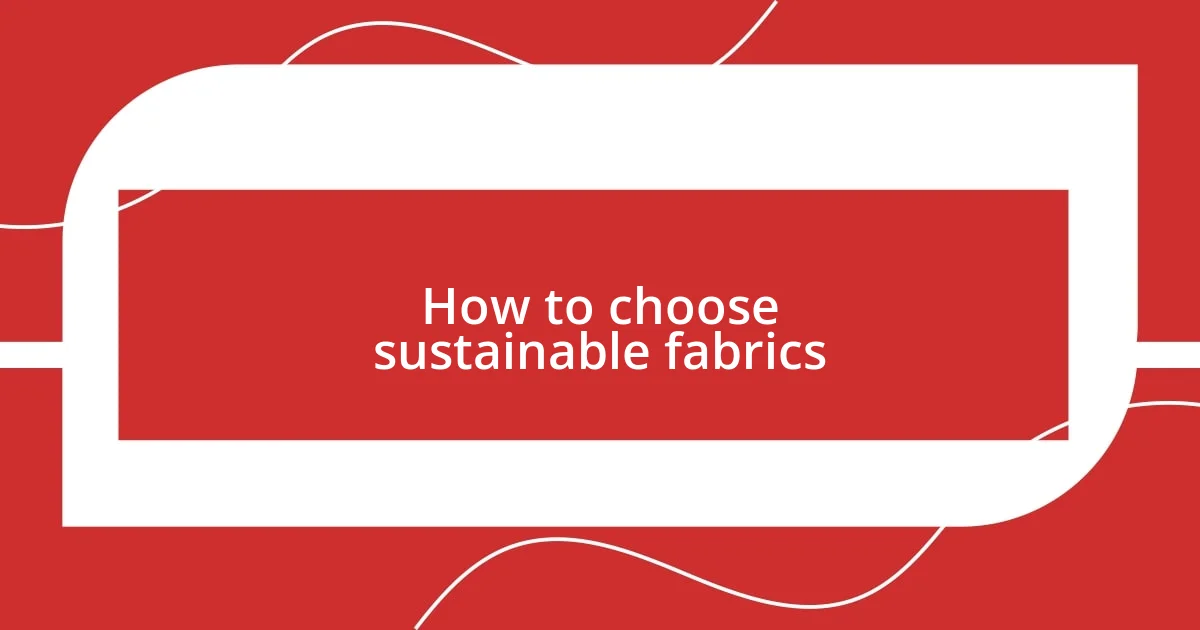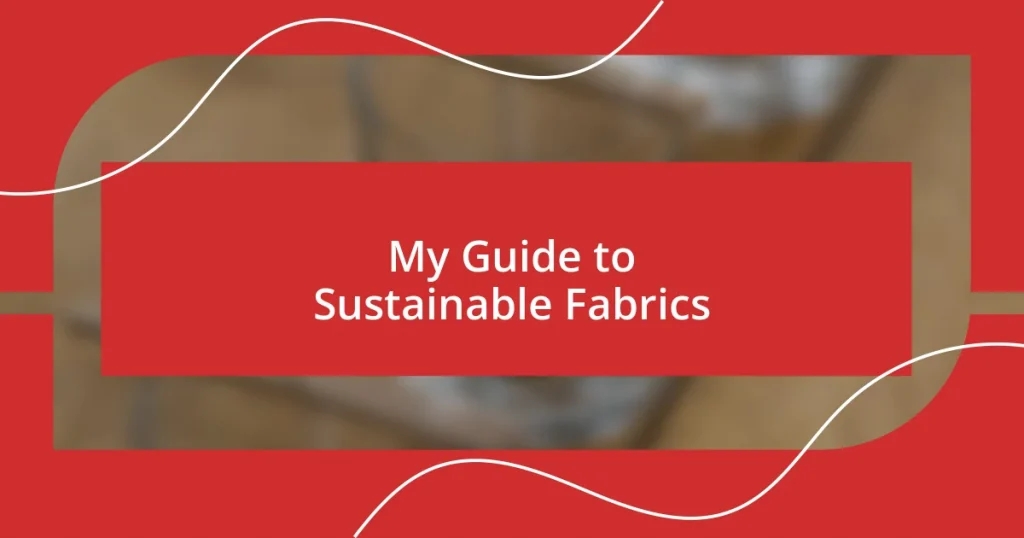Key takeaways:
- Sustainable fabrics, like Tencel and organic cotton, significantly reduce environmental impact and promote healthier practices in fashion.
- Consumer awareness and the rise of innovative materials, such as upcycled fabrics and plant-based textiles, are shaping the future of sustainable fashion.
- Technological advancements could lead to bioengineered fabrics, enhancing our relationship with fashion and fostering a more circular economy.

Understanding sustainable fabrics
Sustainable fabrics are materials designed with a focus on minimizing environmental impact, which fascinates me. For instance, when I switched to organic cotton, I felt a noticeable difference—not just in the softness of the fabric but in knowing that my clothing choices were more eco-friendly. Isn’t it empowering to think that something as simple as our wardrobe can contribute to a healthier planet?
What really struck me is the variety of choices available in sustainable fabrics, from Tencel, made from sustainably sourced wood, to recycled polyester that’s revitalizing discarded plastics. Each option tells a story of innovation and responsibility. Have you ever wondered how many resources go into creating conventional fabrics? The reality is surprising and, frankly, a bit disheartening.
For anyone who cares about style and sustainability, understanding these materials can transform shopping habits. I remember the first time I discovered hemp; I was amazed it could produce such a durable, beautiful fabric while requiring significantly less water than cotton. Wouldn’t it be great if more people recognized the benefits of these fabrics, not just for fashion but for the future of our planet?

Types of sustainable fabrics
Sustainable fabrics come in various types, each with its unique advantages. For instance, I’ve had a memorable experience with Tencel; its silky texture draws you in, while knowing it’s made from sustainably sourced wood makes it all the more appealing. It’s fascinating how such innovations can result in materials that not only look beautiful but also support reforestation efforts.
Another standout fabric is organic cotton. I recall purchasing a couple of organic cotton T-shirts that felt softer against my skin than traditional cotton. This fabric uses fewer pesticides, so when I wear it, I feel like I’m making a choice that contributes to healthier farming practices. As you explore the world of sustainable fabrics, it’s essential to consider how each material can impact both the environment and your lifestyle.
Recycled polyester is particularly noteworthy, fashioned from plastic bottles and other post-consumer products. The first time I wore a jacket made from it, I felt a connection to the circular economy. It’s inspiring to wear something that could have ended up in a landfill, instead being transformed into a stylish and functional piece of clothing. Each type of sustainable fabric offers a pathway to a more eco-conscious wardrobe that everyone can join.
| Fabric Type | Characteristics |
|---|---|
| Tencel | Sustainably sourced wood, soft and breathable |
| Organic Cotton | Grown without pesticides, super soft |
| Recycled Polyester | Made from recycled plastics, promotes circular economy |

Benefits of using sustainable fabrics
There’s something truly rewarding about wearing sustainable fabrics. Each time I slip on a piece made from hemp or Tencel, I feel like I’m not just donning a garment but embracing a philosophy. The knowledge that I’m supporting responsible practices gives me a warm sense of belonging to a community striving for change. My friend recently switched to sustainable fabrics, and she told me her confidence skyrocketed once she realized her fashion choices aligned with her values. It’s that kind of empowerment that makes choosing sustainable options not just logical but deeply satisfying.
Here are some key benefits of using sustainable fabrics that I’ve discovered along the way:
- Reduced Environmental Impact: Sustainable fabrics often use less water and energy in production, lessening their ecological footprint.
- Healthier Choices: Many of these fabrics are produced without harmful chemicals, making them better for both our skin and the environment.
- Durability: Fabrics like hemp or organic cotton often last longer than their conventional counterparts, reducing the frequency of replacements.
- Support for Ethical Practices: By choosing sustainable options, you’re contributing to fair labor practices and supporting communities engaged in responsible production.
- Unique Aesthetics: The textures and colors available in sustainable textiles provide diverse choices that can enhance personal style.

How to choose sustainable fabrics
When I’m on the hunt for sustainable fabrics, I always start by checking the label. Do I really know where this fabric comes from? I can’t stress enough how crucial it is to look for certifications like GOTS (Global Organic Textile Standard) for organic textiles or the OEKO-TEX certification. These labels give me peace of mind that the fabric meets strict environmental and social standards. It’s like getting a behind-the-scenes pass to the garment’s journey!
I also pay close attention to the fabric’s impact on the environment during its production. For example, I remember the first time I bought a linen dress. It was a revelation to learn that flax, the plant used for linen, requires significantly less water and pesticides than cotton. I felt a little spark of joy knowing that my stylish choice was also a greener one. What if more people considered these factors before making a purchase?
Finally, I think about the end of the fabric’s life cycle. I often ask myself: “Will this fabric be recyclable or biodegradable?” I find it incredibly satisfying to choose materials that minimize waste. Recently, I discovered a bag made from biodegradable polyester, which not only looked fantastic but would also naturally decompose after its life was over. It feels empowering to know that my choices can influence a more sustainable future.

Trends in sustainable fabric fashion
The current trends in sustainable fabric fashion are incredibly exciting and reflect a shift in consumer values. I’ve noticed a growing popularity of upcycled materials, where old textiles are transformed into something entirely new. It’s a fantastic way to breathe life into forgotten fabrics, and I personally feel a connection to the history behind each piece. Isn’t it fascinating how a once-loved garment can find a new purpose and tell a different story?
Another trend that’s catching my eye is the rise of plant-based fabrics. I remember trying on a dress made from organic pineapple fiber, known as Piñatex. The texture was soft, yet sturdy, and I felt a sense of pride knowing it was made from agricultural waste. It got me thinking—if companies can innovate with byproducts, why wouldn’t we support fashion that prioritizes creativity and sustainability?
Lastly, collaborations between designers and sustainable fabric producers are becoming more commonplace. One instance that stands out was when my favorite designer launched a line featuring recycled ocean plastics. Wearing that collection gave me an uplifting sense of purpose, knowing I was part of a movement that tackles pollution while looking stylish. I often wonder: how much more can we achieve if we continue to support these eco-conscious partnerships?

Future of sustainable fabrics
As I look toward the future of sustainable fabrics, I can’t help but feel optimistic about technological innovations on the horizon. The idea of bioengineered fabrics, made from fungi or algae, intrigues me deeply. Imagine wearing clothes that not only look good but are also grown rather than manufactured! It’s like the fabric of the future is waiting to unfold, and I can’t wait to see how it reshapes our relationship with fashion.
I also believe that consumer awareness will play a huge role in driving the change. When I see more people actively seeking out sustainable options, it inspires me. I remember a time at a local market, chatting with a vendor who passionately explained how their dyes were derived from natural plants. The enthusiasm was contagious! If we all start engaging with the origins of our clothing in this way, I truly believe it can accelerate the transition toward more ethical practices in the industry.
Looking ahead, I think we’ll also witness an increase in circular fashion models, where brands take back their products for recycling. Picture this: I recently returned a pair of worn shoes to a brand known for their sustainable practices. It felt empowering to contribute to a system dedicated to waste reduction. Isn’t it exhilarating to think that in the near future, our fashion choices could come full circle, creating a positive impact on the planet?















